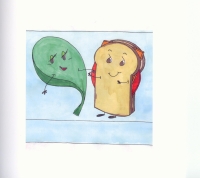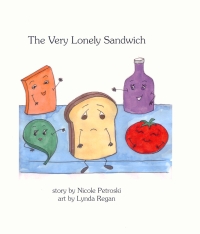| ________________
CM . . . . Volume XVIII Number 23 . . . . February 17, 2012
excerpt:
With The Very Lonely Sandwich, Petroski has utilized the form of the traditional cumulative tale in which action and dialogue repeat and build up as the story progresses. According to a blurb on the back cover, Petroski “wrote The Very Lonely Sandwhich when her niece asked her to write a ‘ten minute story’ about mayonnaise.” A sandwich consisting of just two slices of buttered bread feels lonely and empty inside. When the lonely sandwich meets a piece of mild cheddar cheese, “the sandwich fell in love at first sight” and invites the cheese to join him. The cheese slice agrees, and the sandwich becomes a “delicious cheese sandwich with a very very very thin layer of low-fat butter.” Despite the addition of the cheese slice, the sandwich still feels that something is missing. The pattern of adding additional sandwich fillings repeats three more times, with the two pieces of bread adding a slice of garden fresh tomato, a spinach leaf and finally some “secret sauce.” With the addition of each filling item, Petroski adds to the adjectives describing the sandwich. Unfortunately, she does not do so in an entirely consistent fashion and, thereby, she reduces the expected opportunities in a cumulative tale for young readers to participate in the telling of the story by joining in on the repeating text portions. 
Although the cumulative effect of the adjectives describing the sandwich’s growth is effective, the storyline, itself, is very thin, and cause and effect are frequently missing, with the sandwich’s instant love and the object of his affection immediately responding positively being two examples.
Not recommended. Dave Jenkinson, CM’s editor, lives in Winnipeg, MB.
To comment
on this title or this review, send mail to cm@umanitoba.ca.
Copyright © the Manitoba Library Association. Reproduction for personal
use is permitted only if this copyright notice is maintained. Any
other reproduction is prohibited without permission.
NEXT REVIEW |
TABLE OF CONTENTS FOR THIS ISSUE
- February 17, 2012.
AUTHORS |
TITLES |
MEDIA REVIEWS |
PROFILES |
BACK ISSUES |
SEARCH |
CMARCHIVE |
HOME |
||||||
